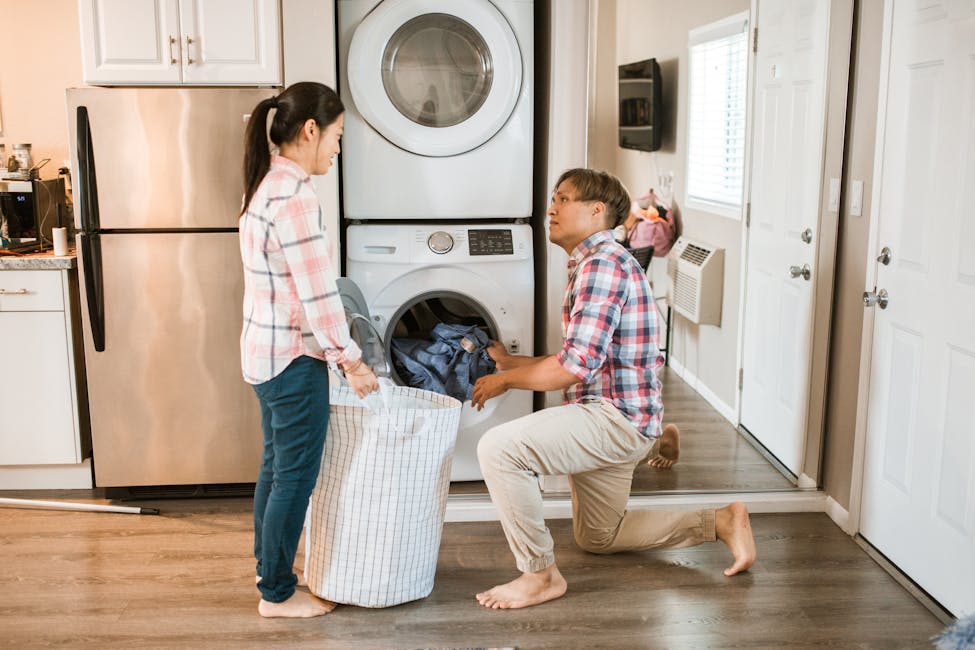For landlords evaluating whether to include a washer and dryer in their rental properties, the decision involves balancing upfront costs against long-term advantages. While many focus solely on tenant appeal and rental premiums, one of the most overlooked benefits is the significant tax advantages these appliances provide. Understanding the complete financial picture can transform what seems like a simple amenity decision into a strategic investment opportunity.
Tax Benefits: The Hidden Financial Advantage
One of the most compelling reasons to include a washer and dryer in your rental property is the immediate and ongoing tax benefits these appliances offer. These advantages can substantially reduce your tax burden and improve your property’s overall return on investment.
Depreciation Deductions
Washers and dryers are classified as personal property with a useful life of five years under IRS guidelines. This means you can depreciate the cost of these appliances over five years using the Modified Accelerated Cost Recovery System (MACRS). For example, if you purchase a washer and dryer set costing $1,500, you can deduct approximately $300 per year from your taxable rental income for five years.
This depreciation is separate from your building depreciation and provides an additional annual tax shield that directly impacts your bottom line. Even if the appliances continue functioning well beyond five years, you’ve already captured the full tax benefit.
Section 179 Deduction
Landlords can potentially take advantage of Section 179 of the tax code, which allows you to deduct the full purchase price of qualifying equipment in the year you buy it, rather than depreciating it over time. For the 2025 tax year, Section 179 allows deductions up to $1,220,000 for qualifying property purchases.
While there are specific requirements and limitations, this means you could potentially write off the entire cost of your washer and dryer set immediately rather than spreading it over five years. This immediate deduction can be particularly valuable in high-income years or when you’re looking to maximize current-year deductions. Consult with a tax professional to determine if your situation qualifies for this accelerated deduction.
Maintenance and Repair Deductions
All maintenance, repairs, and eventual replacement costs for washer and dryer units are fully tax-deductible as operating expenses. This includes:
LIST1
These deductions reduce your taxable rental income dollar-for-dollar, providing ongoing tax benefits throughout the property’s ownership.
Installation and Hookup Costs
The costs associated with installing washer and dryer hookups, including plumbing modifications, electrical work, and venting systems, may qualify as capital improvements that can be depreciated over 27.5 years for residential rental property. Alternatively, depending on the scope of work, some installation costs might qualify as immediate repairs and maintenance deductions.
Calculating the Real Cost
When you factor in tax benefits, the true cost of providing a washer and dryer is significantly lower than the sticker price. Consider this example:
LIST 2
Using Standard Depreciation:
These tax advantages make the investment considerably more attractive and should be a primary consideration in your decision-making process.
Attracting Quality Tenants
In today’s competitive rental market, in-unit laundry facilities have evolved from a luxury amenity to an expected convenience, especially for certain demographic groups. Properties equipped with washers and dryers consistently attract more interest and higher-quality tenant applications.
Families with young children particularly value in-unit laundry, as it eliminates the logistical challenge of hauling loads to laundromats or shared facilities while managing kids. Young professionals and busy career-focused tenants similarly prioritize the time-saving convenience of in-home laundry, viewing it as essential to their lifestyle rather than optional.
The convenience factor extends beyond mere preference. Tenants with washers and dryers in their units avoid the hassle of scheduling around shared laundry room availability, don’t need to carry supplies and laundry baskets through common areas, and enjoy the privacy and security of doing laundry in their own space. For many renters, these factors justify paying premium rent.
Commanding Higher Rental Rates
Including a washer and dryer directly translates into higher monthly rental income. Market data consistently shows that units with in-unit laundry command rental premiums ranging from $50 to $150 per month, depending on the local market and property type.
In competitive urban markets where laundry facilities are less common, the premium can reach the higher end of this range or beyond. Even in markets where washers and dryers are more standard, properties with these amenities consistently rent at the top of the price range for comparable units.
Over the course of a year, this premium amounts to $600 to $1,800 in additional rental income. When compared against the $800 to $2,000 cost of a mid-range washer and dryer set, the return on investment becomes clear. Many landlords recover their initial appliance investment within 12 to 18 months through increased rent alone, not accounting for tax benefits.
Competitive Market Advantage
In markets saturated with rental options, in-unit laundry facilities provide a significant competitive edge. When prospective tenants compare similar properties at similar price points, the presence of a washer and dryer often becomes the deciding factor.
This advantage is particularly pronounced in areas where shared laundry facilities or off-site laundromats are the norm. Your property immediately stands out in online listings, where “in-unit washer/dryer” is one of the most commonly searched amenities. This increased visibility translates into more inquiries, faster rental periods, and reduced vacancy costs.
Properties with washers and dryers also photograph better for listings, as the modern appliances convey a sense of updated, well-maintained living space that appeals to quality tenants browsing online platforms.

Improved Tenant Retention
Tenant turnover represents one of the largest expense categories for rental property owners, including cleaning costs, minor repairs, marketing expenses, lost rent during vacancies, and the time investment required to show the property and screen applicants. Providing a washer and dryer contributes significantly to tenant satisfaction and long-term retention.
Tenants who enjoy the convenience of in-unit laundry are substantially less likely to move when their lease expires. The thought of returning to shared facilities or laundromats after experiencing the convenience of in-home laundry creates a strong incentive to renew. This “amenity stickiness” helps maintain occupancy and protects your rental income stream.
Long-term tenants also tend to take better care of the property, as they view it more as a home than a temporary living situation. The stability of reduced turnover provides predictable cash flow and minimizes the disruptions associated with tenant transitions.
Understanding the Drawbacks
While the benefits are substantial, landlords should carefully consider the potential drawbacks before making a final decision.
Maintenance Responsibilities
Including a washer and dryer means accepting ongoing maintenance obligations. Appliances require periodic servicing, and components will eventually fail regardless of how well they’re maintained. As the landlord, you’re responsible for ensuring these appliances remain in working order throughout the tenancy.
Common issues include drainage problems, door seal failures, heating element burnouts in dryers, and general wear on mechanical components. Depending on usage intensity, you might face service calls several times throughout an appliance’s lifespan. Each service call represents both a direct cost and a time investment coordinating with repair technicians and tenant schedules.
The quality of appliances you initially purchase significantly impacts long-term maintenance costs. While budget models offer lower upfront costs, mid-range to higher-quality appliances from reputable brands typically deliver better reliability and longevity, potentially saving money over time despite higher initial prices.
Significant Initial Investment
Quality washer and dryer sets typically cost between $800 and $2,000 or more, depending on features, capacity, and brand reputation. For landlords managing multiple properties or operating on tight margins, this upfront investment per unit can be substantial.
Beyond the appliances themselves, installation costs may add several hundred dollars if the property requires new electrical circuits, proper venting systems, or plumbing modifications. Stackable units or compact models designed for smaller spaces often carry premium price tags despite their smaller size.
This investment must be evaluated against other potential property improvements that might also attract tenants or justify higher rents, such as updated kitchens, improved flooring, or enhanced outdoor spaces.
Space Constraints
Not all rental properties can easily accommodate washers and dryers. Older buildings, compact apartments, or properties without existing laundry hookups may require significant modifications to create appropriate space.
Adequate space requirements include room for the appliances themselves (standard units require approximately 54 inches width for side-by-side placement or 27 inches for stackable units), proper clearance for doors to open fully and allow loading/unloading, appropriate ventilation for dryers (typically requiring external venting), and access to water supply lines, drainage, and appropriate electrical service.
Converting existing space may mean sacrificing storage areas or reconfiguring floor plans in ways that might not be ideal. In some cases, the space constraints may make including full-size appliances impractical or excessively expensive.
Utility Considerations
If your property’s lease includes utilities in the rent, adding a washer and dryer increases your operating costs. While this concern is more limited in properties where tenants pay their own utilities, it’s a significant factor in all-inclusive rental arrangements.
Washers and dryers can substantially increase water, electricity, and sewer costs. Depending on usage patterns, this might add $15 to $30 or more monthly to your utility expenses. For landlords paying utilities, you must factor these ongoing costs into your calculations and ensure your rental premium adequately covers both the appliance investment and the increased utility expenses.
Important Steps to Rent Your Home Out from A to Z
Step by step checklist for getting a home rented, and link to the full property management guide
1 Consider strengths and weaknesses for your home and location and consider special strategies to utilize them. Is it a college area? If so, you’ll likely handle a lot differently from low income, or a suburb

2 Get the property in show-ready condition by handling repairs, but also low-cost aesthetic fixes like spray painting rusted AC grates, and other things that really stand out. A sure way to attract sub-par tenants and repel the rest is to show a home with unrepaired issues
3 Decide whether you’re going to allow pets or not. Before you decide, know that for most landlords it’s the single best thing you can do to increase your “bottom line” profit over the long term. More on this subject here

4 Set a rental rate that will balance a minor amount of time on market hassle, with monthly rate. Whether in the form of owner-occupied showings, stress, or vacancy. Most owners fail to properly account for these subtle but real costs, especially vacancy. Vacant homes are much more costly than most account for. We can provide a free rental rate estimate compiled by people, not an algorithm, here
Making the Strategic Decision
The choice to include a washer and dryer should be based on a comprehensive analysis of your specific property, target tenant demographic, local market conditions, and long-term investment goals.
Properties targeting families, young professionals, or tenants willing to pay premium rents will see the most benefit from including laundry facilities. In competitive rental markets where differentiation matters, or in areas where most comparable properties lack in-unit laundry, the competitive advantage is magnified.
When factoring in the substantial tax benefits through depreciation and potential Section 179 deductions, combined with rental premiums and improved tenant retention, the financial case for including washers and dryers becomes increasingly compelling. The key is ensuring your increased rental rate adequately covers the appliance costs, maintenance expenses, and any additional utilities while still offering tenants perceived value.
For most landlords operating in competitive markets with appropriate space and targeting middle to upper-middle income renters, including a washer and dryer represents a sound investment that pays dividends through reduced vacancy rates, higher rental income, and significant tax advantages.
Action Steps
If you’re considering adding washers and dryers to your rental properties:
1. Consult a tax professional to understand exactly how you can maximize depreciation benefits and whether Section 179 deductions apply to your situation
2. Research local market rental premiums for units with in-unit laundry to ensure adequate return on investment
3. Evaluate your property’s infrastructure to determine installation requirements and costs
4. Consider appliance quality carefully – mid-range models from reliable brands offer the best balance of initial cost and long-term reliability
5. Review your lease terms to clearly specify maintenance responsibilities and proper appliance use
6. Factor in insurance considerations – ensure your landlord policy adequately covers appliance-related damages
With careful planning and proper execution, including a washer and dryer can be one of the most profitable improvements you make to your rental property, delivering benefits that extend far beyond simple tenant convenience.









